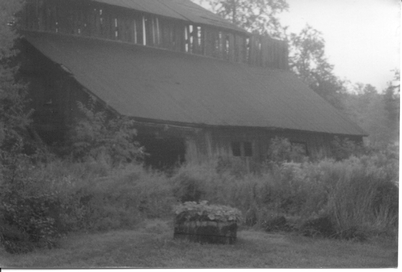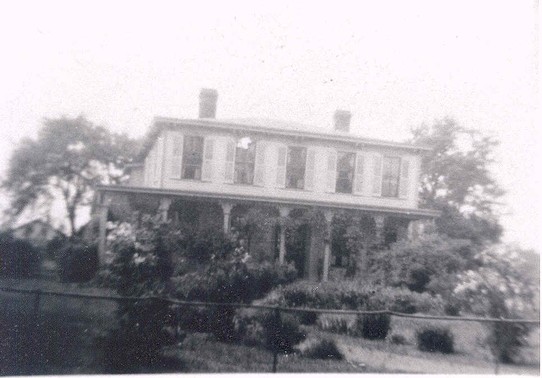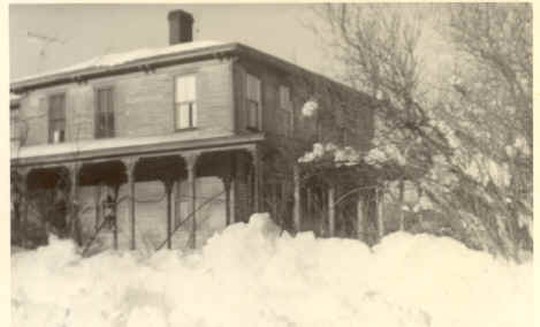Mr. William P. Wilcox, a merchant from Connecticut, was a land agent for Mr. Andrew M. Jones of the Richards and Jones Land Company. He and his family settled in a small valley along the Milesburg-Smethport Turnpike, just north of what is now the Elk County line in McKean County sometime around the 1830’s. The small village was fittingly called ” Williamsville”. A small spring still exists there along the state roadway today.
Here Mr. Wilcox erected a hotel and tavern along the Milesburg – Smethport Turnpike directly across from the spring and water trough that was provided as a stopping station for stagecoach lines. After a while, Wilcox had decided to move his family to the higher ground about a mile south-west in the Rasselas farming district. Here he constructed a rather small but comfortable one and a half story dwelling, a small saw mill, and a large barn.

Mr. Wilcox became interested in politics serving in both the Pennsylvania Senate and House of Representatives. As a land agent, in 1856, he was very instrumental in negotiating a very large sale of land to the Elk & McKean Land Improvement Company of Philadelphia. It just so happens that a major stockholder of this company was prominent Philadelphia Judge John K. Kane who convinced the Board of Directors to hire his son, Thomas L. Kane, to manage this large purchase of newly acquired land in the wild lands of Pennsylvania.
Since Kane was somewhat unfamiliar with the area, he worked with Wilcox during the summer of 1856 to survey the vast tracts of recently purchased land. Also about this time Wilcox had decided to move again, this time to Port Allegany, where he pursued other business and political motivations. He was later elected Judge in McKean County. Wilcox later died in 1868 and he is buried in Port Allegany.

While surveying a route through this tract of land in 1856 to construct a railroad, Kane often would board at the Wilcox home in Rasselas. In the spring of 1857 he sent for his wife and, after leasing the property for two (2) years, later outright purchased the Wilcox property in 1858. Kane gave the name “Upland” to this new residence and made it his summer home, never having fully residing here much more than a few years on a temporary basis. While staying in Rasselas, Kane constructed a beautiful home in the nearby town of Kane, which was later named in honor of him.
In April 1861, Kane sought permission from the Governor to raise a company of riflemen from among the hardy woodsmen of the area to support the Union’s Civil War efforts. As such, the 13th Pennsylvania Reserves, the “Bucktail Regiment,” was recruited from the timbering counties of northwestern Pennsylvania. Each man who traveled along the “Bucktail Trail” to join the regiment’s rendezvous point along the Sinnemahoning River at Driftwood wore civilian clothes and a buck’s tail in the back of his hat – as a fitting symbol of his superior marksmanship.


During the Civil War Kane was promoted to the rank of brigadier general. He had served along side of, and became very good friends with General Ulysses S. Grant. After the war, Grant was later elected President of the United States, and he paid a few visits to his good friend Kane at his beautiful Upland estate. The old register of the Wilcox House bears Grants name on it’s hotel register.
As a famous Civil War Veteran, Kane also entertained many other guests and dignitaries at his Upland summer home. On August 15, 1869 President Grant along with several other VIP’s, including Assemblymen and Senators gathered for a fishing trip at Straight Creek. Among this elite group was Captain Antony A. Clay. Upon their arrival at Upland, the party proceeded on the turnpike reaching Straight Creek as the group spent the day fishing. Grant was said to have caught about two dozen red speckled trout. The party later gathered nearby at a small log structure, known as “Mineral Shanty” which was built earlier by Captain Clay as a hunting and fishing outpost.
Captain Clay had first arrived in Elk County in 1866 engaging in farming and lumbering operations. In 1874, Kane sold his Upland Estate to Clay, who five years later would construct the famous Clay Mansion in Rasselas. Desiring to construct his new residence at about the same location as the original Wilcox home, he had the small home re-located behind where he wanted to build the new mansion. At Upland, Clay, along with wife Sybella and four daughters erected the Manson and resided there for many years. Clay was later elected to represent Elk County in the State General Assembly as a democrat in 1886.
As a result of Captain Clay residing in Rasselas, the Post Office in Williamsville was later relocated and officially renamed to Rasselas. Also, the Erie Railroad was later constructed and installed a passenger terminal on Rasselas Wilcox Browns’ property. Also the Rasselas Telephone Company Inc. was later established to provide phone service to the Clay estate.


The former Wilcox / Kane summer home can be seen to the back left of this early photo of the Clay Mansion. Note the building still has it’s shutters next to each window.
Clay lived at Upland, mostly in the summer months, while wintering in Philadelphia, up until his death in 1906. The Upland Estate was still being occupied by Clay’s two daughters for a few years, who also later moved to Philadelphia. During this period of time after Clay’s death, the daughters allowed the mansion to become run-down and avoided the required maintenance of the structure. The structure was beginning to deteriorate badly.

The property and the large parcel of land formerly known as “upland” was later purchased by Mr. Roy Smith in 1946 by the last surviving heir of the Clay estate, Mrs. Marian Franks of Philadelphia. Mr. Smith and his wife Mary Ann never lived in the old mansion, preferring instead to reside in the old Wilcox home to the rear of the mansion. Mr. Smith also operated a small general store at this location for many years. The mansion was later demolished around 1994 with some of the impressive hardwood flooring and other hardwood trim being removed, some say for firewood.




